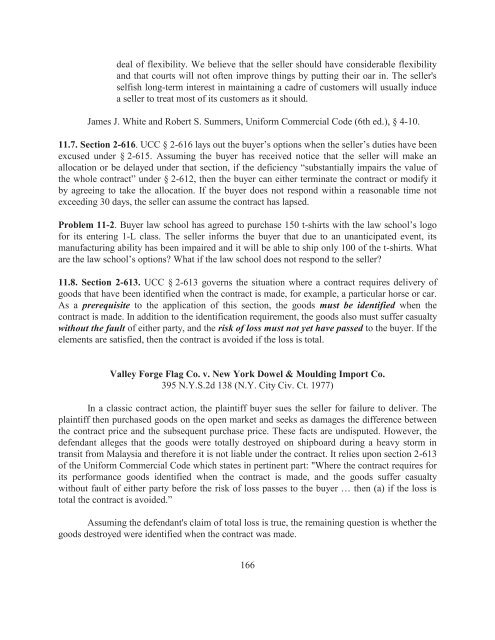Sales and Leases - A Problem-based Approach, 2016a
Sales and Leases - A Problem-based Approach, 2016a
Sales and Leases - A Problem-based Approach, 2016a
Create successful ePaper yourself
Turn your PDF publications into a flip-book with our unique Google optimized e-Paper software.
deal of flexibility. We believe that the seller should have considerable flexibility<br />
<strong>and</strong> that courts will not often improve things by putting their oar in. The seller's<br />
selfish long-term interest in maintaining a cadre of customers will usually induce<br />
a seller to treat most of its customers as it should.<br />
James J. White <strong>and</strong> Robert S. Summers, Uniform Commercial Code (6th ed.), § 4-10.<br />
11.7. Section 2-616. UCC § 2-616 lays out the buyer’s options when the seller’s duties have been<br />
excused under § 2-615. Assuming the buyer has received notice that the seller will make an<br />
allocation or be delayed under that section, if the deficiency “substantially impairs the value of<br />
the whole contract” under § 2-612, then the buyer can either terminate the contract or modify it<br />
by agreeing to take the allocation. If the buyer does not respond within a reasonable time not<br />
exceeding 30 days, the seller can assume the contract has lapsed.<br />
<strong>Problem</strong> 11-2. Buyer law school has agreed to purchase 150 t-shirts with the law school’s logo<br />
for its entering 1-L class. The seller informs the buyer that due to an unanticipated event, its<br />
manufacturing ability has been impaired <strong>and</strong> it will be able to ship only 100 of the t-shirts. What<br />
are the law school’s options? What if the law school does not respond to the seller?<br />
11.8. Section 2-613. UCC § 2-613 governs the situation where a contract requires delivery of<br />
goods that have been identified when the contract is made, for example, a particular horse or car.<br />
As a prerequisite to the application of this section, the goods must be identified when the<br />
contract is made. In addition to the identification requirement, the goods also must suffer casualty<br />
without the fault of either party, <strong>and</strong> the risk of loss must not yet have passed to the buyer. If the<br />
elements are satisfied, then the contract is avoided if the loss is total.<br />
Valley Forge Flag Co. v. New York Dowel & Moulding Import Co.<br />
395 N.Y.S.2d 138 (N.Y. City Civ. Ct. 1977)<br />
In a classic contract action, the plaintiff buyer sues the seller for failure to deliver. The<br />
plaintiff then purchased goods on the open market <strong>and</strong> seeks as damages the difference between<br />
the contract price <strong>and</strong> the subsequent purchase price. These facts are undisputed. However, the<br />
defendant alleges that the goods were totally destroyed on shipboard during a heavy storm in<br />
transit from Malaysia <strong>and</strong> therefore it is not liable under the contract. It relies upon section 2-613<br />
of the Uniform Commercial Code which states in pertinent part: "Where the contract requires for<br />
its performance goods identified when the contract is made, <strong>and</strong> the goods suffer casualty<br />
without fault of either party before the risk of loss passes to the buyer … then (a) if the loss is<br />
total the contract is avoided.”<br />
Assuming the defendant's claim of total loss is true, the remaining question is whether the<br />
goods destroyed were identified when the contract was made.<br />
166


















